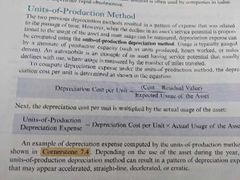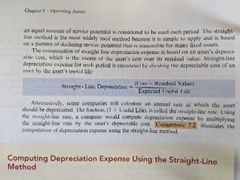![]()
![]()
![]()
Use LEFT and RIGHT arrow keys to navigate between flashcards;
Use UP and DOWN arrow keys to flip the card;
H to show hint;
A reads text to speech;
40 Cards in this Set
- Front
- Back
|
Classify operating activities on a statement of cash flows |
Cash flows from operating activities correspond to the cash effects of items that determine net income (on the income statement) |
|
|
Classify investing activities on a statement of cash flows |
Cash flows from investing activities relate to increases or decreases in long-term assets and investments |
|
|
Classify financing activities on a statement of cash flows |
Cash flows from financing activities involve cash receipts and parents that affect long-term liabilities and stockholders' equity. |
|
|
Where would interest, received or paid, go on a statement of cash flows? |
Operating activities |
|
|
Where do dividends received go on a statement of cash flows? |
Operating (though IFRS allows them on either operating or financing) |
|
|
Where do dividends paid go on a statement of cash flows? |
Financing activities (though IFRS allows them on either operating or financing) |
|
|
Where does the payment of interest go on a statement of cash flows? |
Operating activities |
|
|
What order should accounts appear in the trial balance sheet? |
Assets, liabilities, equity, revenues, expenses |
|
|
What are the three key elements of accrual accounting? |
Time-period assumption, revenue recognition principle, expense recognition principle. |
|
|
Define the time-period assumption |
The accounting cycle of a business can be divided into equal (if artificial) time periods. |
|
|
Define the revenue recognition principle |
Revenue is recognized (recorded) in the period in which a company satisfies its performance obligation, regardless of when cash is received. |
|
|
Define the expense recognition principle |
An expense is recorded when it is incurred, regardless of when cash is paid. Expenses only include costs incurred to earn revenue in the same accounting period. |
|
|
What are the four types of adjusting entries |
Accrued revenues, accrued expenses, deferred (unearned) revenues, deferred (prepaid) expenses |
|
|
Define accrued revenues |
Assets resulting from revenues that have been earned but for which no cash has yet been received |
|
|
Define accrued expenses |
Liabilities resulting from expenses that have been incurred but not yet paid in cash |
|
|
Define deferred (unearned) revenues |
Liabilities arising from the receipt of cash for which revenue has not yet been earned |
|
|
Define deferred (prepaid) expenses |
Assets, arising from the payment of cash, that have not been used or consumed by the end of the period. |
|
|
What accounts have a normal debit balance |
Assets, expenses, and dividends |
|
|
What accounts have a normal credit balance |
Liabilities, stockholder equities, revenues |
|
|
What are the permanent accounts? |
Assets, liabilities, and stockholders' equity |
|
|
What are the temporary accounts? |
Revenues, expenses, dividends |
|
|
Units of production depreciation method |

|
|
|
Declining balance depreciation method |

|
|
|
Straight-line depreciation |

|
|
|
What payroll taxes are deducted from wages (and included in wages expense)? |
Social security taxes payable, medicare taxes payable, federal income taxes withholding payable |
|
|
What payroll taxes must be paid by the employer (and balances by a matching liability payable)? |
Federal unemployment tax expense, state unemployment tax expense, social security tax expense (appears on both as same amount), medicare tax expense |
|
|
Current ratio formula |
Current assets / current liabilities |
|
|
Quick ratio |
(cash + marketable securities + accounts receivable) / current liabilities |
|
|
Cash ratio formula |
(cash + marketable securities) / current liabilities |
|
|
Operating cash flow ratio |
Cash flows from operating activities / current liabilities |
|
|
Effective interest expense formula |
Carrying value x yield rate x time (in years) |
|
|
Debt to Equity Ratio |
Total liabilities / total equity |
|
|
Debt to total assets ratio |
Total liabilities / total aasets |
|
|
Long-term debt to equity ratio |
Long-term debt / total equity |
|
|
Times interest earned ratio (accrual basis) |
Operating income / interest expense |
|
|
Times interest earned ratio (cash basis) |
Can flows from operating activities + taxes paid + interest paid / interest paid |
|
|
Gross margin calculation |
Gross profit / net sales |
|
|
Inventory turnover rayio |
COGS / Average inventory |
|
|
A stage days to sell inbentory |
365 / inventory turnover |
|
|
Gross profit |
Revenue - COGS |

